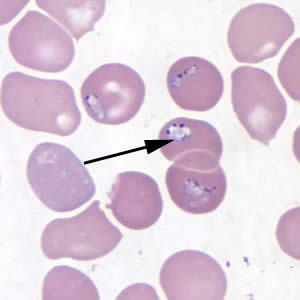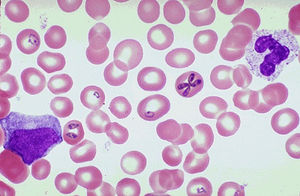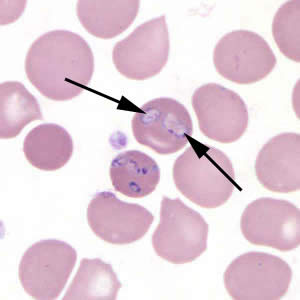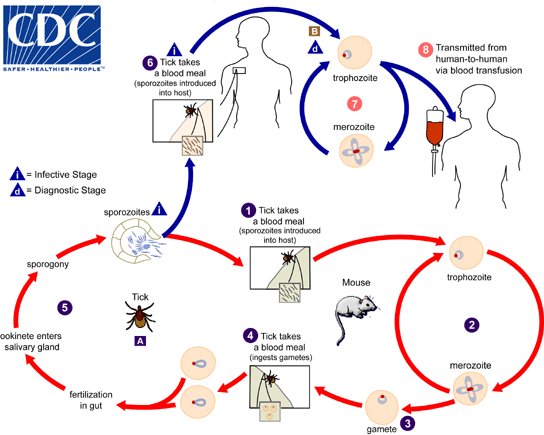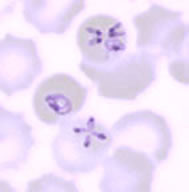Babesiosis
As Babesiosis is referred to by the Babesia (small intracellular parasites that are transmitted by tick bite) caused infectious disease. The disease is similar in some aspects of malaria. Apart from humans also occur in various other mammals caused by Babesia diseases on, for example, in the dog ( the dog babesiosis ) in cattle, sheep, goats and deer (see classification of Babesia ).
Pathogens, epidemiology, clinical
Causative agent of the disease are small protozoa of the genus Babesia. The pathogens occur worldwide and are by ticks of the genus Ixodes in various vertebrates ( eg, mice, dogs, horses, cattle) and humans. In Europe, in humans dominate infections caused by Babesia divergens, in the United States by Babesia microti ( on the East Coast and in the Midwest ) and Babesia duncani ( on the north west coast). Babesia microti is transmitted by Ixodes scapularis same tick species that transmits the agents of Lyme disease and ehrlichiosis.
Since Babesia infected erythrocytes, they can also be transmitted through blood transfusion. For this reason, are excluded from blood donation to babesiosis ill. Also a congenital transmission of Babesia is possible.
The parasites infect the erythrocytes ( red blood cells) and lead, depending on the parasite density to a more or less pronounced hemolysis. In humans, the disease is rarely diagnosed, making sure it is in part that the infection often proceeds clinically inapparent. In the U.S. state of New York a total of only 136 cases of disease were recorded in the 20 years 1970-1991, however, it had in some regions of New England up to 7 % of the population antibodies against Babesia. Patients who have an immunodeficiency ( eg HIV infection or after splenectomy ) show a much more severe and may life-threatening course. Although Babesia were discovered as the causative agent in cattle in 1888 by the Romanian researchers Victor Babeş, dated the first case of human disease scientifically described only from the year 1957.
Diagnostics
The diagnosis is made by direct microscopic detection of the parasite ( as typically apply here, however, the rarely seen "Maltese Crosses" ) or at a lower parasite density by detecting the parasite genome by polymerase chain reaction (PCR).
In veterinary medicine, chronic Babesiosis are known, as the difficulty of being able to establish the pathogen. Changes in the blood picture could give first evidence of babesiosis, but is certainly to be considered also in human medicine that other pathogens may exhibit such changes in the blood picture.
Because of the known in veterinary medicine difficulty of detecting the pathogen is likely to be borne in mind that the detection of pathogens in humans designed to equally difficult, especially since very little is known about the chronic course of the disease in humans. The chronic course is known in veterinary medicine for years, further research is urgently needed. There are over a hundred different Babesia species known, some of them such as Babesia canis are considered exclusively host-specific. From veterinary medicine it is known that Babesia can be transmitted through the placenta from an infected mother to her unborn child.
Treatment
The treatment of babesiosis of man is done with antibiotics. We recommend the following schemes:
High density parasites in the blood or immune also exchange transfusion can be carried out.


